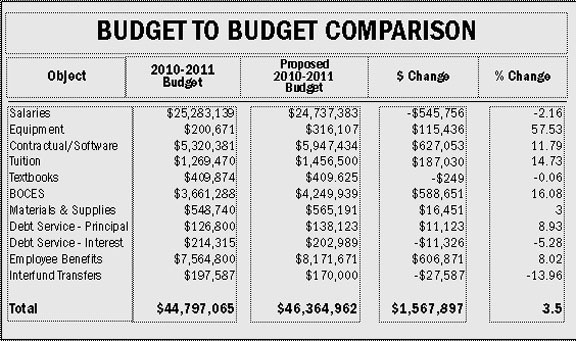Proposed budget presented to Malverne School Board
Throughout the next two months, the Malverne Board of Education will face the challenging task of reviewing and revamping the 2010-2011 proposed budget, which was presented to the board during a meeting last week by Superintendent Dr. James Hunderfund and Raymond Neblett, business administrator.
Sitting in the quiet library at Malverne High School the night of Tuesday, Feb. 9, board members listened as the proposed $46.3 million budget was broken down into details and Hunderfund and Neblett explained the need for a 3.5 percent increase from last year's budget.
"It's a starting point," Hunderfund said of the budget during an interview with the Herald. "I really do believe the board is going to refine it considerably." But, he added, the budget was already significantly reduced from the original 7 percent proposed increase. "I tried to be as responsive to the needs of the children as I could be, yet represent what the economy is going to dictate."
Neblett, although always a self-described optimist, said there was no choice but to reduce the increase drastically. "We looked at the whole thing and said, 'OK, let's be practical now.' We really had to push back." Although he is staying optimistic about the possibility of getting the proposed budget passed this spring, he conceded that "the board, at the end of the day, they make the call."
Among the areas that required the largest proposed increases, which together totaled $2.1 million, were employee benefits, tuition for charter school students and equipment. Contractual costs, including transportation, and expenditures related to the Board of Cooperative Educational Services, which primarily deals with students with special needs, also contributed greatly to the total.
Areas where spending was cut, bringing down the total proposed budget increase to $1.56 million, were mostly personnel-related. Neblett noted that the district could save $355,000 if one out-of-district special education program, which includes one teacher, one teacher's assistant and a monitor, was brought back into the district.
During the meeting, Neblett explained that the district is mandated to provide services for students with special needs, but that it spends even more money on tuition for charter school students. Next school year, some 15 Malverne children will likely attend area charter schools -- a decision made by their parents, but paid for by the district taxpayers. The district must pay about $16,000 per student, resulting in a total bill of $240,000. After a parent asked why the district must pay for those students, Neblett said that if the district refuses to pay the tuition, the state will simply deduct those funds from the district's state aid. In an interview with the Herald, Neblett said it's likely the number of students attending area charters schools will increase every year.
Among the reasons Hunderfund gave for proposed increases was the boost in enrollment expected in the district: for the 2010-2011 school year, enrollment is projected to increase by 38 students, a 2.2 percent increase. According to Hunderfund, that number will continue to grow every year, as a 2 percent increase is expected annually for the next three or four years. But, he told the Herald, personnel and programming are the areas that require the largest financial increases.
More than half of all school district spending goes to salaries, while some 18 percent goes to benefits and 17 percent to contractual costs and textbooks. Salaries accounted for $24,737,383 in spending for the 2010-2011 budget -- a $545,756 reduction from last year's budget. "We really have a lot of good people here," Hunderfund said of school district employees, "and they're doing a great job, but, unfortunately, we can't offer everyone the same thing next year."
In addition to salaries, the areas in which spending was cut are textbooks, debt service (interest) and interfund transfers, which together totaled a decrease of $39,162. Meanwhile, contractual costs went up from the 2009-2010 budget by almost 12 percent, putting the total at $5.9 million, while employee benefits went up 8 percent to $8.7 million.
The Malverne BOE is expected to review the budget on Feb. 23. Budget adoption and public discussion will take place on April 20 and the budget vote is scheduled for May 18. For more information, visit the Malverne Union Free School District website at www.malverne.k12.ny.us.
Comments on this story? LLandor@liherald.com or (516) 569-4000 ext. 205.






